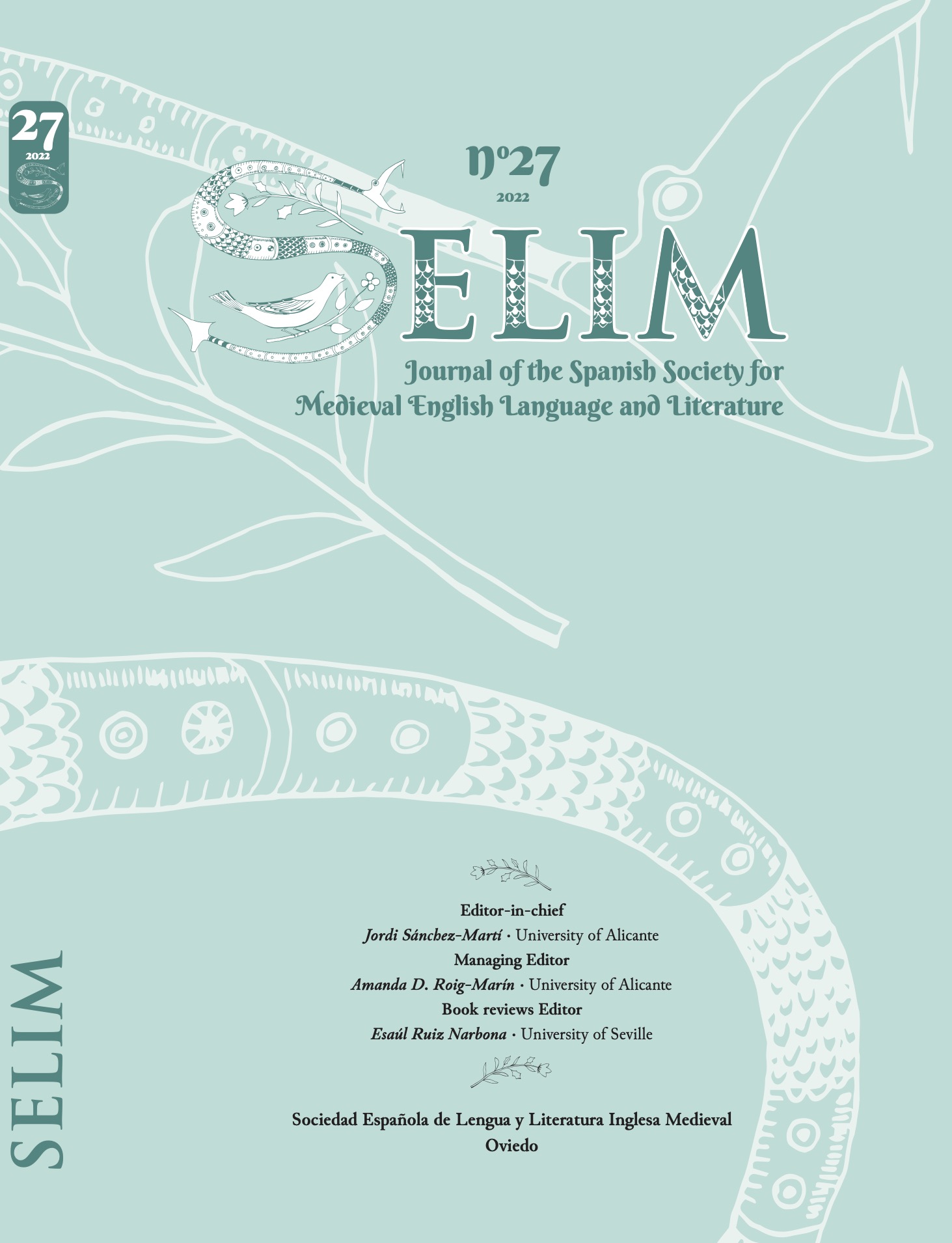Abstract
Drawing on the recent studies on aesthetic emotions and on their recent application to the field of the Old English aesthetic emotions, this paper explores one emotion from the emotion family of AMAZEMENT in the Old English poetic corpus, attending to the type of wonder that is typically triggered by objects of beauty, excellent manufacture and by the natural world. The purpose of this paper is to understand better the poetic usage of the Old English terms for wonder as well as evidence their role in literary and everyday contexts. Through a fine-grained analysis of the above domains, this paper has shown that the wonder implicit in these texts can be triggered by perceptual or cognitive appraisals, but also by a combination of both, highlighting the complexities and particularities of the early medieval English emotion of WONDER, as well as its similarity to other emotions like the EXPERIENCE OF BEAUTY or AWE.
References
Brewer, K. 2016: Wonder and Skepticism in the Middle Ages. London, Routledge.
Dailey, P. 2012: Riddles, Wonder and Responsiveness in Anglo-Saxon literature. In C. A. Lees ed. The Cambridge History of Early Medieval English Literature. Cambridge, Cambridge University Press: 451–472.
Fingerhut, J. & J. Prinz. 2019: Wonder, Appreciation, and the Value of Art. Progress in Brain Research 237: 107–128.
Fingerhut, J. & J. Prinz. 2020: Aesthetic Emotions Reconsidered. The Monist 103.2: 223–239.
Gevaert, C. 2007: The History of ANGER: The Lexical Field of ANGER from Old English to Early Modern English (PhD dissertation). Leuven, University of Leuven.
Gónzalez, R., J. Smith & L. Nielsen. 2017: Editorial Overview: Theories, Methods, and Applications of Mixed Emotions. Current Opinion in Behavioural Sciences 15: iv–vi.
Hill, J. M. ed. 2010: On the Aesthetics of Beowulf and Other Old English Poems. Toronto, University of Toronto Press.
Izdebska, D. W. 2015: The Semantic Field of ANGER in Old English (PhD dissertation). Glasgow, University of Glasgow.
Juslin, P. N. 2013: From Everyday Emotions to Aesthetic Emotions: Toward a Unified Theory of Musical Emotions. Physics of Life Reviews 10.3: 235–266.
Keltner, D. & J. Haidt. 2003: Approaching Awe, a Moral, Spiritual, and Aesthetic Emotion. Cognition & Emotion 17.2: 297–314.
Kövecses, Z. 2010: Cross-Cultural Experience of Anger: A Psycholinguistic Analysis. In M. Potegal, G. Stemmler & C. Spielberger eds. International Handbook of Anger. New York, NY, Springer: 157–174.
Menninghaus, W., V. Wagner, J. Hanich, E. Wassiliwizky, T. Jacobsen & S. Koelsch. 2017: The Distancing-Embracing Model of the Enjoyment of Negative Emotions in Art Reception. Behavioral and Brain Sciences 40: 1–63.
Menninghaus, W., V. Wagner, E. Wassiliwizky, I. Schindler, J. Hanich, T. Jacobsen & S. Koelsch. 2019: What Are Aesthetic Emotions? Psychological Review 126.2: 171–195.
Minaya Gómez, F. J. 2019: As Beautiful Inside, as It Is Outside: On the Connection between Beauty and Morality in the Old English Corpus. Complutense Journal of English Studies 27: 205–221.
Minaya Gómez, F. J. 2020: Mixing Pleasure and Beauty: Positive Aesthetic Experience in Old English Poetry. Journal of English Studies 18: 153–179.
Minaya Gómez, F. J. 2021: The Lexical Domain of BEAUTY and its Metaphors in the Anglo-Saxon Formulaic Style. Berlin, Peter Lang.
Minaya Gómez, F. J. Forthcoming: Wonder and the Supernatural in Old English Verse: An Assessment of WONDER as a Potentially Mixed Emotional Response. In J. Enrique Díaz Vera & E. M. Porter eds. Cultural models for Emotions in North Atlantic Vernaculars: 700-1400. Turnhout, Brepols.
Nelson, M. 1978: The Paradox of Silent Speech in the Exeter Book Riddles. Neophilologus 62: 609–615.
Ramey, P. 2017: The Riddle of Beauty: The Aesthetics of Wrætlic in Old English Verse. Modern Philology 114.3: 457–481.
Scherer, K. R. 2005: What Are Emotions? And How Can They Be Measured? Social Science Information 44.4: 695–729.
Walker, C. 1997: Wonder. American Historical Review 102.1: 1–17.
Williamson, C. 2017: The Complete Old English Poems. Philadelphia, University of Pennsylvania Press.

This work is licensed under a Creative Commons Attribution-NonCommercial-NoDerivatives 4.0 International License.
Copyright (c) 2022 SELIM. Journal of the Spanish Society for Medieval English Language and Literature.




